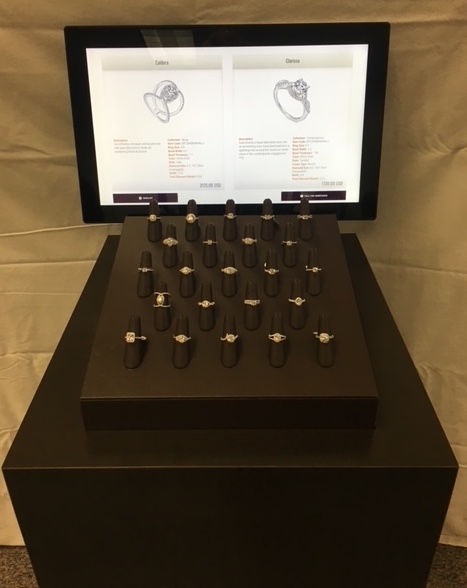Articles and News
Leslie McGwire: New Technological Trends for Interior Design of Jewelry Stores | October 03, 2024 (0 comments)

Leslie McGwire: New Technological Trends for Interior Design of Jewelry Stores
West Bloomfield, MI--In the competitive world of retail and interior design, the ambiance of a jewelry store can significantly influence customer behavior and overall sales. New innovative design trends are set to revolutionize jewelry interior store spaces, enhancing the shopping experience, and driving business success.
The key interior design strategies that can elevate jewelry stores, creating inviting and dynamic environments that captivate consumers and boost profitability. By understanding and implementing these few technological design trends, jewelers can not only attract more customers but also foster loyalty, encouraging shoppers to return time and time. A thoughtful interior design floor plan can transform the jewelry environments and create memorable experiences.
The Traditional Jewelry Sales Approach
In a typical jewelry sales environment, customers can view jewelry on display within the glass cabinetry and displays. Generally, to try on jewelry, learn more about pricing and other features of the jewelry, a customer must approach a sales associate. The sales associate may then determine the needs of the customer. The needs or wishes of a customer may include specific types of jewelry interested in, if there is a special occasion related to the potential jewelry purchase. If there is a purchase for the customer or for another individual(s), the owner has a sense of the budget for the purchase, and personal taste.
There are a variety of issues that the sales associate or owner may develop from a customer. For example, if the associate develops a relationship with the customer, the sales associate may find that the customer is interested in a specific piece of jewelry, yet different issues may arise, which not limited to the following:
(1) Above their budget.
(2) Are indecisive in their product tastes.
(3) May even become uncomfortable with the sales process.
(4) If the jewelry is intended as a gift, the sales associate may determine that a customer does not know the jewelry tastes of the intended potential customer.
(5) There are also times when a customer feels uncomfortable even approaching a sales associate.
(6) The customer may be concerned with being judged by a sales associate based on their own personal appearance, available budget, and the like.
(7) The customer may even be apprehensive about being pressured into a purchase.
(8) Also, similar concerns may arise beyond jewelry sales as owners know.
(9) Most significantly with the traditional jewelry sales process, a customer may come in and out of a store without leaving behind any personal information for subsequent contact from the store.
(10) A sales associate may have helped the customer narrow down options in a potential jewelry item, but the customer may have to quickly leave to attend to other personal matters (e.g., childcare, work, meetings, etc.).
(11) Most importantly, without the customer’s information, a sales associate may be unable to follow-up with the customer to further or complete a sales transaction by having contact information for the client. Sometimes an intended recipient of a jewelry gift purchase wants to visit a jewelry store to gain a better understanding of their own tastes and preferences (See picture Bridal Customers from Wedding Market Research Co: 216% Millennials are more likely to be influenced by in-store Smart Jewelry kiosk touch screen displays).

[216% Millennials are more likely to be influenced by in-store Smart Jewelry kiosk touch screen displays. Photo credit: Leslie McGwire]
(12) The customer may feel uncomfortable approaching a sales associate and trying out different jewelry items as no purchase is intended to be made.
(13) Additionally, there may be no record left of what the customer’s personal tastes are after trying on different pieces of jewelry. The customer may then have to directly share his or her favorite jewelry items with the potential customer and thus spoiling a potential surprise, raising a conversation about budget, or both.
(14) As an alternative, a sales associate may have to document an intended recipient’s tastes which not only takes additional time but may then create an awkward conversation with the potential customer (e.g., gift giver).
Interior Design with New Integrating Technologies Trends
The fusion of technology and interior design is shaping the future of a paradigm shift for jewelry stores. Interactive Smart Jewelry Kiosks with RFID (Radio Frequency Identification) technology and their placements in the store are critical to ROI. The location of kiosks is an important factor for interior design/floor plans of the placement in the store. This is where the Interactive Smart Jewelry Kiosks are because of the frequency of Gen X, Gen Y, Gen Z, Millennials, Baby Boomers, and younger couples visit often. These are Smart Jewelry Kiosks which can provide an interactive experience for the customer without relying on developing a relationship with a sales associate in an appropriate place of the store. What is needed is a way for a customer to comfortably physically and/or virtually try on and learn about jewelry interest without needing to interact with a sales associate.
[Smart jewelry Kisok. Photo credit: Leslie McGwire]
What is needed is a unique way for an owner to gather customer information to determine the needs of the customer more quickly to provide a comfortable environment for the customer and increasing the chance of a sale. This is a way for a jewelry store owner to gather customer information to allow future contact with the customer and using the gathered data for market analysis. The approach is an unconventional jewelry sales approach to establishing a relationship between a potential customer and a sales associate at a store without having to initially interact face-to-face (see picture of a small jewelry kiosk with the customer comparing several ring choices). The design look of the Smart Jewelry Kiosk Base can be designed to fit the overall image and feel of the showroom.
For instance, Interactive Jewelry Smart Kiosk can allow customers:
(1) To visualize how jewelry pieces will look in their hands, etc. with view on computer monitor. (2) The present kiosk which may be able to provide an interactive experience by providing the tech interface portion in communication with a graphic interface portion (i.e., computer monitor) that are able to display and relay information regarding jewelry to the sales associate. (3) A tech interface portion may be able to display jewelry in a temporary removable manner to allow a customer to remove and try on the accessories.
(4) The tech interface portion can detect removal of one or more jewelry pieces and may initiate one or more graphic interface portions to display information on the monitor related to removed jewelry pieces to a customer.
(5) Therefore, the Smart Jewelry Kiosk may be able to collect and transmit information related to a customer so a jewelers may be able to gather customer information, determine a customer’s needs, contact a customer after they leave the jeweler or sales associate, or any combination thereof. The interior design placement is essential for the kiosk to be successful to provide an unconventional approach to establishing a relationship between a sales associate and a customer by first allowing a customer to interact with the jewelry displayed on the kiosk to determine a user’s needs (e.g., budget, tastes, items of interest) without having to interact face-to-face with a sales associate.
(6) Thus, by the time customer is ready to interact with a sales associate, the kiosk has facilitated establishing a relationship by having the sales associate already informed of the customer’s needs without having the customer feel uncomfortable which displays on the sale associate phone, I-PAD, or computer.

[Smart mirror. Photo credit: Leslie McGwire]
Another essential technological trend is the Smart Mirrors which displays the customers an immersive jewelry shopping experience. The placement of a Smart Mirror in a jewelry store should be carefully identified by an interior designer to maximize ROI. By integrating these technologies, owners can create a modern, engaging environment that attracts tech-savvy customers and enhances overall satisfaction (See picture of a Smart Mirror with a female freely choosing different necklaces on).
Additionally, incorporating digital signage can streamline the shopping experience by providing real-time information on promotions and product availability (See picture of a female in the digital signage). The interior design placement of this digital signage is essential in the store even with the limits of wall space. This design placement is critical to provide comfortable tone to the store. Jewelry owners can also use these technologies to gather data on customer preferences and behavior, enabling them to personalize marketing efforts and improve inventory management. This seamless integration of interior design with technology, not only enhances the customers experience, but also provides valuable insights for optimizing jewelry store designs and operations.

[Digital signage. Photo credit: Leslie McGwire]
Creating Experiential Zones with the Floor Plan
Because of these non-traditional technological experiential jewelry approaches are gaining momentum as stores evolve from mere transactional spaces to destinations for unique experiences. Designating special areas for these product demonstrations, and tech-savvy approaches, can draw customers in and encourage deeper engagement with the brands. These experiential tech zones provide opportunities for customers to interact with jewelry meaningfully, fostering brand loyalty and encouraging word-of-mouth promotion. The more enjoyable and fun experiences allow customers to gain hands-on experience with the jewelry, increasing the likelihood of purchase. By creating memorable experiences, jewelers can differentiate themselves from competitors and build stronger connections with their customers.
Prioritizing Comfort and Convenience
These comfortable technological trends have changed the environment can significantly enhance customer experiences. Thoughtful interior design elements such as seating, clear signage, and spacious aisles make shopping more enjoyable and accessible around the Smart Jewelry Kiosks, Smart Jewelry Mirrors and digital signage. Additionally, incorporating convenient features like charging stations and Wi-Fi can keep customers in the store longer, increasing the likelihood of purchases.
Jewelers can prioritize comfort and convenience, and they are likely to see improved customer satisfaction and higher sales. For example, strategically placed these technological approaches need to be in areas provide spots for the customer, while well-lit, clearly marked paths guide them effortlessly through the store. Furthermore, a thoughtful interior design layout will minimize congestion and optimizes traffic flow can reduce stress and create a more relaxing jewelry environment. By addressing these comfort and convenience design factors, owners can create an inviting atmosphere that encourages customers explore more from jewelry interior designers specializing with these technologies in the floor plan process.
About the Author: Leslie McGwire™ has over 35 years in tech-business development, interior design, equipment, furniture sales and marketing services in retail and jewelry-based businesses. Leslie has won 25 national design awards, including the prestigious Salon Today and INSTORE Jewelry Store awards. Leslie has a true passion for business, design for the jewelry and retail industries. Visit lesliemcgwire.com for more information.








